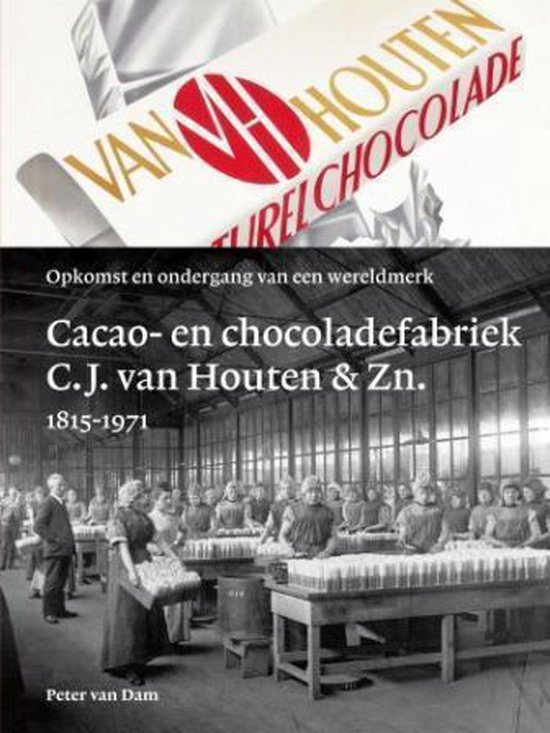VAN HOUTEN: A WORLD TRADE-MARK IN COCOA AND CHOCOLATE
Aspects
from a company history 1815-1971
The cocoa and chocolate industry in
our country assumed high proportions during the
last quarter of the nineteenth century. In its original form this
branch of industry
has now completely disappeared. Up till now a thorough
history has been missing. The production process
of cocoa-powder has been a sole Dutch discovery. In 1827 Casparus
van Houten discovered in Amsterdam a solution for the age-old
problem that chocolate-powder(cocoa- powder) was lying heavily
on the stomach because of a too high percentage of fat. By means
of squeezing roasted
cocoa–beans, part of this cocoa-fat could be removed in this process, as a result
of which cocoa-
powder was gained
on the one hand and on the other hand cocoa -butter. Cocoa-butter, however, is necessary
again during the preparation of chocolate. Moreover, Coenraad Johannes van
Houten developed the
secret process for alkalising cocoa-mass, as a result of which aroma,
smell and taste
strongly improved. In April 1828,
a patent was given by King William
I for a period of ten years.
A development that brought
about a great revolution within the growth potential of a national cocoa and
chocolate industry. A cocoa and chocolate industry that ultimately would
greatly contribute to the export of products and goods. It gave a world reputation to our country. The following companies : Droste, Driessen, Bensdorp,
Blooker, Pette, Grootes, de Jong
and Korff could also amply profit
from the further
growth for each company separately. During a time that
many products were sold loose,
Van Houten presents
the product of chocolate-powder (cocoa-powder) in labelled bottles. After
that there was a quick switch
over to tins. Thus, in 1829, one of the first registered trade-marks
came into being in our country. Then Van Houten put into practice a sales
organisation and advertising design by making
millions of guilders available for this purpose. The objective was to make clear to the world that only Van Houten produced the best cocoa-powder (from 1897 onwards also chocolate products). All means
were used to propogate this reputation further
in the world : Farces,
comedies, advertising films,
musical scores, posters, chromos, advertisements, colouring-books
and picture postcards besides the numerous artistically executed packages and
a sponsored publication of ”Ons Eigen Tijdschrift”.(=Our
Own Magazine). Van Houten cocoa
and chocolate :” De beste
en voordelig in gebruik”(=The
best and cheap)
would be a world-embracing household word. In the
course of years an elite of graphic designers, at home and abroad, has plunged into the
package design and the artistic design for advertising. To mention some names : Theo
van Hoytema, Privat
Livemont, Johan Georg
van Caspel, Johan Briede, Bernhardina
Midderigh-Bokhorst, Freddie Langeler, and Stefan Schlesinger, After World War II
: Frans Mettes, Karel Suyling, Gerard Wernars, Thomas Posthuma, Erik
Thorn Leeson and
Kees van Roemburg. “Van
Houten Anders dan Anderen”(=Van Houten
in every way different from the
others) The
outcome of all these advertising efforts and the strict maintenance of the level of quality resulted into the export to more than 80
countries. Van Houten subsidiary companies were
active in England,Germany and France besides
their own established sales offices in New York, Singapore and Malaysia. The scene
of the big sales success
is mainly laid
after 1880 until
the sixties of the previous century.
In 1971, the Van Houten
company, since 1850 established in Weesp, would
close down to the bewilderment of everybody.For
employment and welfare
services Van Houten
offered a welcome
progress in the fortress
town of Weesp,
under the smoke
of Amsterdam. Provisions in welfare work and in the
cultural field could be achieved through the initiatives introduced by Van
Houten. The population growth increased thanks to the
coming of the Van Houten
“poedermeiden” (=powder girls). Many aspects
from the history
of the company, up till the seventies one of the
biggest export companies in our country,
are brought together
in this richly illustrated book and it got
its final form through an extensive survey of sources and archives during
a period of 8 years.





Reacties
Een reactie posten